There’s a deleted scene from Thor where the big guy and his brother have a chat right before he goes into the grand hall to be coronated. (We all remember how well that works out for him.) He’s got the jitters and Loki is engaging in a good old game of brotherly banter to get Thor’s mind out of Lake Anxiety. The teasing eventually falls back onto their associative animals, drawing attention to Loki’s glorious, horned helm.
But… where’d he get that thing anyhow?
Asgardians are beings with abilities beyond our comprehension, access to materials we can barely conceive of, and a knowledge of the working universe that makes our meager understanding look oh-so-very quaint. It stands to reason that some of these powers come off like magic to those of us who have no knowledge of the realm. And it really doesn’t help that by and large, Asgardians are master show-people. They don’t do anything by halves, and they certainly don’t display themselves in a manner any less than regal.
But it’s fair to guess that not everyone from Asgard acquits themselves like a god. Some citizens of Asgard undoubtedly have more abilities than others, abilities that are likely bequeathed on them by the Allfather himself. After all, if Odin has the ability to take Thor’s power from him, he was likely the person who handed it over in the first place. This would make sense for Loki as well. Though his tricks are all his own, his actual abilities—his animal associative and the rest—do not reflect his Frost Giant heritage; they are absolutely Asgardian in nature.
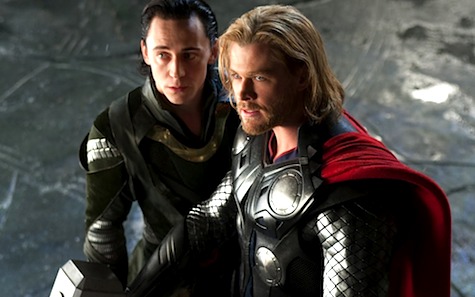
So it’s probable that these powers were bestowed on Thor and Loki at a coming-of-age point for the young princes. Odin probably had a great big to-do ceremony for each in turn, talked about how awesome they were to the Asgard court (do they have a court?), then handed over some super-juice and let his kids mess around for the next few years to figure out how they would embody what he had given them. You can imagine how much Thor made fun of Loki when Odin told his younger son that his identifying animal would be a cow. I’m a bird like father! Thor probably said. And Loki jabbed right back at Thor for not being something more fierce, like a bear or a komodo dragon. But Odin gave them both what he saw in them, and no one was about to question the Allfather in his wisdom.
One fascinating aspect of their power is that image and attire seem heavily tied to it: when Odin takes Thor’s power from him before banishing him to Earth, it rips Thor’s armor from him, as well as his cape (the same is true from what we see of Loki in prison on Asgard). When Thor later proves himself and retrieves Mjolnir, the cue that he has been restored is the return of those particular garments. This happens again in The Avengers; Thor is wearing a dressed down version of his armor to bare his biceps to all those petty, tiny humans, but when he decides to join the fray, he is instantly swathed in space metal, head to toe.
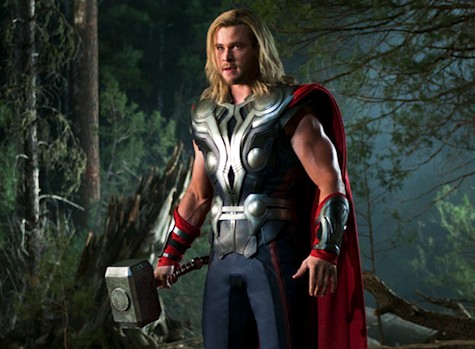
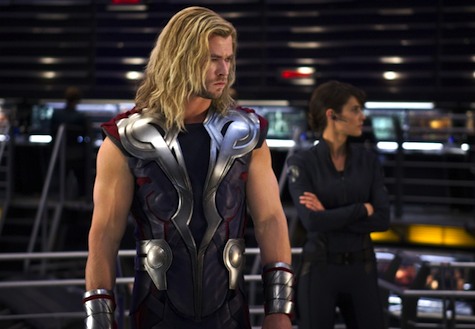
If you take a good look at the armor in the first two images of the post, you’ll notice that the mail on his arms actually goes under the chestplate, so it’s not as though he sheathes just his arms and moves on—it’s materializing beneath the chestplate as well, more likely. In addition, the vambraces he’s wearing in his opening Avengers scene (above, top image) are not the same as the ones he is wearing later on the hellicarrier (above, bottom image), which are decidedly thinner, more ornamental. Thor’s I’m-in-polite-company vambraces? So there’s an array of possibilities, depending on what Thor would prefer to display.
Loki’s an even better example of this because he enjoys deceiving those around him. He constantly changes his appearance based on what deems appropriate for the scenery, like his dapper coat and opera scarf when he harvests a scientist for an eye scan. Loki’s clothing can be so disassembled that the gold plates on his leather outwear frequently go missing, and his helmet disappears and reappears at will. He gives the metal embellishments on his coat a brassy tarnish when he’s not in full showboating mode. We watch him consciously choose to disarm himself in front of Captain America and Iron Man; when he wants them to know he’s surrendering, he simply dissolves any part of his couture that suggests he might be up for a fight. Where does it go? Into the ether? Does is wait for him in some sub-dimension until he retrieves it?
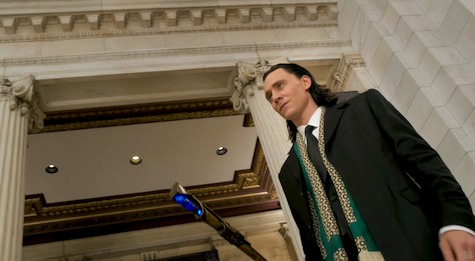
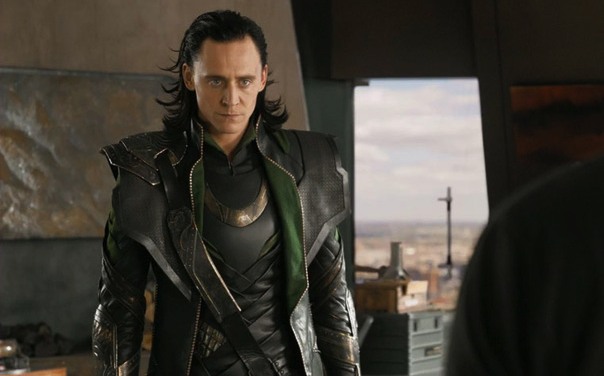
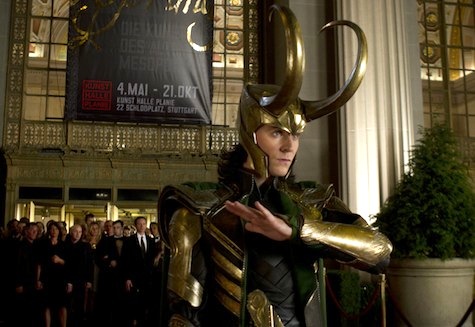

And can these manifestations change depending on how the characters change themselves? Thor’s uniform has remained much the same from his first film, but set pictures from The Dark World reveal some changes, the most notable being armored trousers. Loki’s has altered quite a bit, including one amusingly significant difference—his helmet’s horns have grown. Whether this is meant to be a show of strength or simply the size of Loki’s ego (or a change to compensate for the volume of his hair?), what’s more interesting is to wonder how conscious the alterations are. Did Loki deliberately make the horns more prominent, or is it meant to be a subconscious cue to anyone in contact with him? It’s especially intriguing because Loki’s original armor in Thor clearly echoes his brother’s and Odin’s. That Thor would choose to model his image after his father is no surprise; Loki’s subtle adoption of certain flourishes suggests that he initially does consider himself to be part of their family, but later dismisses that bond entirely.
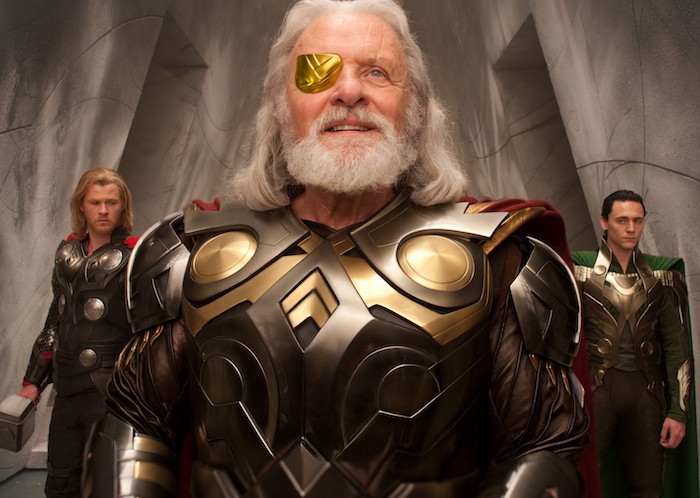
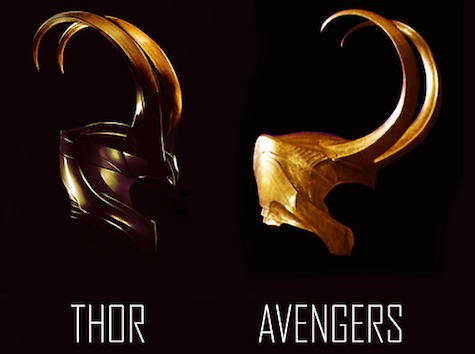
Another question: are their accouterments real, physical things? Mjolnir always exists, even if Thor’s not wielding it. The hammer can be found wherever he last set it down, but his super-god cape is not the same. So either Asgardians have the ability to rearrange matter on a whim into their gear, or the armor and clothes are… energy based? Infusing too much actual science into it likely won’t make sense, but with fakey sci-fi science, you could make an argument that the images Thor and Loki project are not part of the physical realm as we understand it. The items they display to go along with those images clearly interact in a manner that plays in this realm—offering warmth, protection from blows, etc.—but they are not simply made from metals and leathers and woven cloth.
Which does mean that, unless implied undergarments are not part of the power display… Thor and Loki could be naked. At any time. Naked and simply shrouded in energy that takes on all the aspects of clothing and armor.
I apologize for this hypothesis, but really. It needed saying.
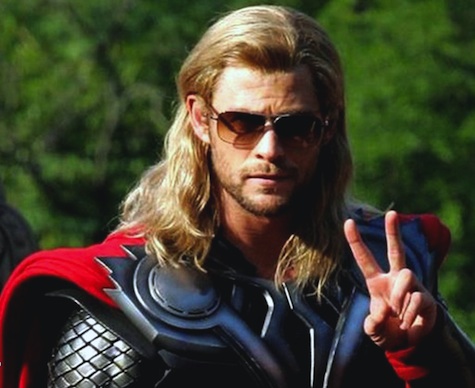
Emmet Asher-Perrin admits that her real problem is spending too much time looking at detailed costume pictures for all the things she likes. She has written essays for the newly released Doctor Who and Race and Queers Dig Time Lords. You can bug her on Twitter and read more of her work here and elsewhere.










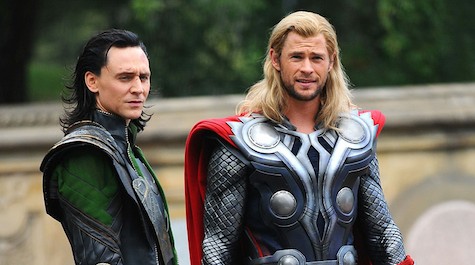
I love this article, if only because I find myself spending loads of time analyzing why movie and tv characters do/say some things. It’s always fun (to me, anyway) to add a bit of myself to a movie backstory, plus it makes it easier for me to support my suspension of disbelief if I come up with a logical reason for what might have been a mistake on a writer’s part.
before he goes into the grand hall to be coronated
Or, as we say here in Midgard, “crowned”.
Just a tiny nitpick: Isn’t Thor wearing vambraces? Gauntlets should cover the hands, as far as I know.
On topic: Depending on the point of view, the difference between matter and energy isn’t all that great – makes sense that physical gods don’t give a damn.
Though it raises the question: will we ever see a trickster who takes that ability away, instantly?
Please, there is no reason to apologize for that hypothesis. Perhaps the lack of illustrations, but not the hypothesis itself.
In War for the Oaks, the Phouka is able to pull clothes from an invisible closet. I see no reason why Midgardians can’t do the same.
I don’t have my old issues of The Official Handbook of the Marvel Universe at hand, but I do remember that a lot of instant costume changes were explained by matter being “shunted to or retrieved from a pocket dimension” or similar handwavium.
@torvald Nom – Ack! Thanks so much for pointing that one out – you are 100% correct.
We also shouldn’t forget:
While we consider the cow a lame animal – it is an incredibly useful animal. Milk, cheese, beef, lawn mowing services, etc.
To the people when Loki & Thor were created? Even more important and useful.
Bird: pretty, but not very useful unless you train it to hunt with you.
What should bend your mind is how energy in reality is bound together creating the perception of solidity and mass. As Torvald said, all mater is energy. The only difference is our more crude methods of gettin’ naked, not the fact that we are all naked under our clothes, asgardian and human alike.
A wonderfully neat nitpicking – I never thought I would be looking into the little things but you do it oh so well. The rationalizations of these little things are quite engaging especially when they inadvertently feed the movie’s mythology and concept. I didn’t like the rationalization of the Aesir as Aliens initially but somehow it was clever – and it worked! Magic is indistinguishable from advance technology. So if those fashion-beyond godly attires are energy-based or even based on some advanced shunting or warping technology (think Stargate’s Goa’uld [i]Ra), why not? I’m all for it. The naked part? Crazysexycool bonus.[/i]
Thor would “bare” his arms, not “bear” his arms for people to see. He could indeed bear arms but that’s not the same as baring his arms.
*crawls back into grammar nitpicker hole*
Maybe the Asgardians just discovered “unstable molecule” clothing technology before Reed Richards did. Other aliens are shown to have, e.g. the Kymellians in Power Pack.
Clothing has always been a symbolic motif in the rhetoric of mythic figures. Mythic figures are associated with their motifs as performing certain functions and setting them apart from each other–this is especially important because mythic figures’ personalities are directly tied to their actions, and because it was often possible to confuse some of the Greek mythic heroes with their associated Gods or patrons.
Depending on the situation, those motifs change. For example, in Greek mythology, Athena is always depicted with the Aegis if she was in battle–as she was a war goddess (not to be confused with a Goddes of War)–a set of scales–as she was also the goddess of practical life–or an owl–as she was also the goddess of widom.
In this sense, Norse myth does not vary from Greek myth much. Loki’s horns are a motif, as are Thor’s cape and Mjolnir. The association of objects and clothing in Norse myth goes hand-in-hand with the didactic messages associated with each figure, just like in tales of Greek mythic heroes, such Orpheus’ lyre–don’t point out to me the fact that more than one person in Greek myth had a lyre. We’re talking mythic figures in this argument, not the gods themselves, which I should probably clarify that for the purposes of this argument, Thor and Loki are both gods and mythic heroes (which are different) in that taken out of their context, Asgard, they are thrust into our context, Midgard. As we know from John Milton, this context shift condenses their power and draws them down into a level of understanding that we as humans can comprehend. I would point out here that the reference to the scientific nature of Asgard’s “mythic” realm is just such a nod in Milton’s direction. Going back to Loki’s attire in the first Thor as being modeled after Odin’s, it is hardly worth mentioning. Loki only suspected he was adopted in the first Thor. His abandoning of his traditional attire after discovering this to be true leaves little wonder about.
Also common in metafiction is the drawing of one’s eye to motifs. In this article, the fact that each mythic figure’s clothing changes according to situation is a fantastic representation of these characters as classic mythic figures, whose motifs represent their present actions and the didactic message associated with each phase. Loki’s attire when he takes the scientists eyes was meant to draw our attention to the mythic figure’s ability to blend in, a trickster’s tactic. As an audience, we are not surprised; we know that this is part of Loki’s character.
I am very surprised I did not notice the more subtle changes to Loki and Thor’s armor in relation to their combat status. Thank you so much for pointing this out. Now I want to go re-watch the films so that I can see it for myself.
My argument contains lots of Loki. I studied Loki because I have a massive crush on Tom Hiddleston. #HiddlesArmyForever
Just want to point out that when people started to copy Thor’s Avenger’s outfit for Comic-con, people realized that in the combat scenes from Whedon’s film Thor’s vambraces are decorated with a stylized image of a helmet with horns that looks exactly like you-know-who, presumably in honor of his lost brother: “We thought you dead.”
He’s not sporting them anymore in the trailer for Thor 2, though.
The only question i have is can we get a Thor Helmet that looks good and can be worn in battle. It is kind of off having massive battles in fun armour by the hero (Thor) yet his head remains unprotected. I realize it is done for asthetics, and the fact Thor has a hard head, but the helmet has been all but abandoned, and shouldn’t be.
@11 So I guess Thor is exercising his right to bare arms…
Emily, In composing this article, did you start by thinking of their attire, and then let this train of thought lead you to imagining these gods being naked, or did you imagine these gods as naked, and then work backwards from there?
;-)
Myself, I just think that the gods have pockets on their clothes that are bigger on the inside, where they can stash all manner of useful items and baggage.
I suspect Ms Asher-Perrin has been reading a lot of the same fanfic I have – Thor tends to be portrayed within Avengers fandom in particular as having a bit of difficulty remembering he needs to wear trousers (or indeed any garment at all) in “family” situations.
Also, I suspect Loki’s totem animal isn’t the cow, so much as the Bull (or aurochs, as the Romans phrased it) – the “wild bull” of early European mythology. Or, alternatively, and given the horns he sports, much more likely, the ram or billy goat. Given Thor in myth is given a chariot drawn by two goats, it’s not unlikely that Loki in his “tamer” form is associated with these animals which are renowned not only for their adaptability (a trait to be admired) but also for their stubbornness, their ability to eat anything set before them (Loki in myth is renowned as a bit of a gourmand, almost able to out-eat the personification of fire – it may be he’s the Asgardian most likely to give Volstagg a run for his money at the buffet table) and for their strangeness. Goats were a power totem in early European myth, which is why the early Christians went to a lot of effort to associate worshipping anything goat-like with “ye powers of darknesse”.
Megpie71 @17 “Goats were a power totem in early European myth…”
Avram Davidson used this idea in one of his Dr. Eszterhazy stories (“The Autogondola Invention”). Uncle Johnus, a peasant from Hyperborea, one of the provinces of the Triune Monarchy of Scythia-Pannonia-Transbalkania, has traveled to the Imperial Capital of Bella in search of advice and aid in dealing with what seem to be malign enchantments afflicting their goat flocks. He takes his problem to the learned Dr. Eszterhazy, telling him: “Goats were very canny creatures, Uncle Johnus said…he-goats in particular. They could perfectly well remember that once upon a time in old pagan days they had been worshiped as gods (“They mammals was mommets, in them days,” he put it).”
(“The Adventures of Doctor Eszterhazy”, p. 74)
There is actually a brief scene in the Age of Ultron trailer where Thor is naked.
I am pretty sure Loki uses his “Pocket” dimension. It’s where he keeps the tesseract. Because we know that the tesseract is a real thing and he can make it appear if he has is in said pocket. So it could be the same thing with his helmet and clothes
I’m comfortable with saying it’s magic, or science so advanced as to be identical to magic, and leaving it at that. But what an intriguing thought!
Pockets of infinite holding :-)?
I want to know what powers these garments armours have. Duribility, stregth, speed, energy. As Odin tore them away what power did each have and represent? Of anyone has these answers please let me know.
Of course, the Aesir — the citizens of Asgard — sub-contracted all their miraculous apparatus construction to the residents of Svartalfheim, the dwarfs
I’m fairly sure Loki’s clothes are illusions, which are like a magical layer that outstrips his true, physical appearance. that would mean he’s wearing simple clothes or whatever he puts on in the morning (or nothing at all) with an illusion of armour. I mean, who can blame him? That stuff must take forever to put on.